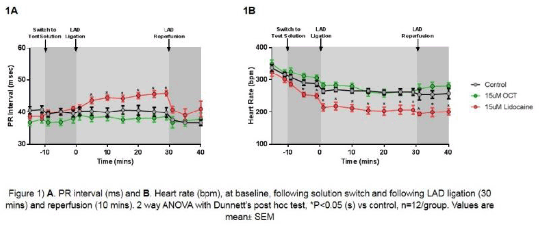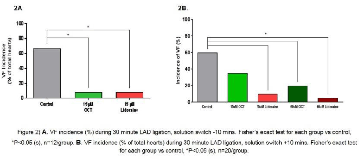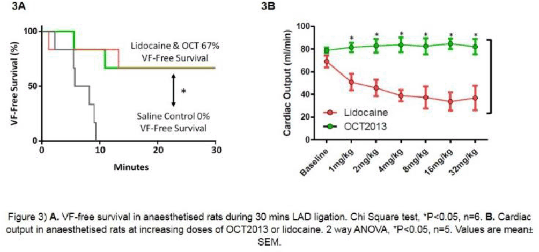Print version
Search Pub Med
- L. M. Hesketh1
- N. S. Peters2
- L. Mahoney Sanchez3
- S. E. Harding2
- C. D. Wilder1
- M. B. Sikkel2
- M. J. Curtis1. 1Cardiovascular Division
- King's College London
- London
- United Kingdom
- 2National Heart and Lung Institute
- Imperial College London
- London
- United Kingdom
- 3King's College London
- London
- United Kingdom
| 169P London, UK Pharmacology 2017 |
Development of OCT2013, a hypoxia-activated prodrug of lidocaine, for the treatment of ischaemia-induced ventricular fibrillation
Introduction: Sudden cardiac death (SCD) resulting from acute myocardial infarction (AMI) remains a substantial clinical burden, accounting for 50% of deaths from cardiovascular disease (1). Ischaemia-induced ventricular fibrillation (VF) is thought to be responsible for 80% of SCD related to AMI (2). Antiarrhythmic drugs are associated with dose-limiting adverse effects. OCT2013, a hypoxia-activated prodrug of lidocaine, has been synthesised and its effectiveness and safety were assessed in Langendorff-perfused rat hearts and in anaesthetised rats.
Methods: Male Wistar rat (295-400g) hearts were Langendorff-perfused with Krebs’ (3mM K+) before left coronary artery (LAD) ligation (30mins). A switch of perfusate to vehicle, 15μM lidocaine or 15μM OCT2013 was made 10 mins before ligation (n=12), or, to vehicle, 15μM lidociane, 60μM lidocaine, 15μM OCT2013 or 60μM OCT2013 10 mins after ligation (n=20). In both, the incidence of VF was recorded, plus ECG measures. Male Sprague Dawley rats (450-700g) were mechanically ventilated and anaesthetised with isoflurane+O2 (1.5-2,5%, 90-100 breathes/min, 3-4mL). In one experiment, infusion of saline or 2mg.kg-1 (+0.5mg.kg-1.min-1) lidocaine or OCT2013 (i.v.) began 5 mins prior to 30 mins LAD ligation (n=6). In another experiment (n=5), cardiac output (ml.min-1) was measured by left ventricular catheterisation. 1-32mg.kg-1 OCT2013 or lidocaine was administered in a dose-doubling manner (i.v.). Incidence of VF was analysed via Fisher’s exact test. Where appropriate, other data was analysed by two-way ANOVA followed by Dunnett’s post hoc test. Significance was set at p<0.05. All experiments were blinded and randomised, in accordance with BJP guidelines (3).
Results: Lidocaine and OCT2013 were equi-effective at inhibiting VF, whether administered before (Fig 2A) or after ischaemia onset (Fig 2B) in Langendorff preparation. OCT2013 didn’t induce dose-limiting bradycardia or PR interval elongation, in contrast with lidocaine (Figure 1A, 1B). Coronary ligation in vivo revealed similar antiarrhythmic effectiveness of OCT2013 and lidocaine via Kaplan Meier analysis (Fig 3A). In dose-doubling experiments in anaesthetised rats, cardiac output was significantly reduced by lidocaine, but unaltered by OCT2013 up to 32mg.kg-1 (Fig 3B).



Conclusion: OCT2013 inhibited ischaemia-induced VF in Langendorff and in vivo rat models of AMI, and was as effective as lidocaine. Unlike lidocaine, however, its effects were not limited by adverse effects on cardiac output, PR interval or heart rate. Further investigation is required to define the full profile of OCT2013.
References:
1. Kudenchuk, P.J., et al. (2012). Circulation 125: 1787-1794.
2. McElwee, S.K., et al. (2016). J. Nucl. Cardiol. 23: 1368-1379.
3. Curtis, M.J., et al. (2015). Br. J. Pharmacol. 172: 3461-3471

